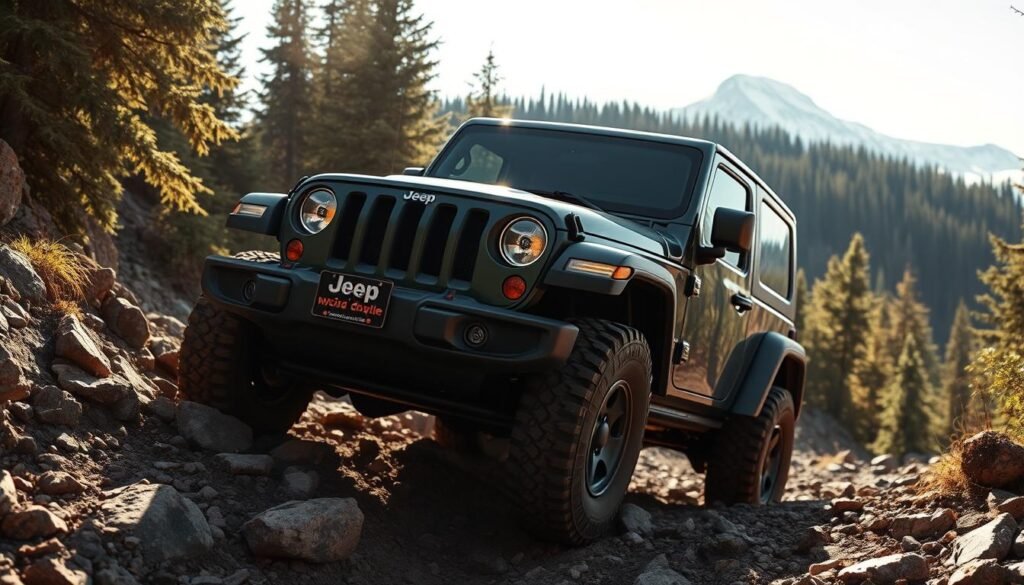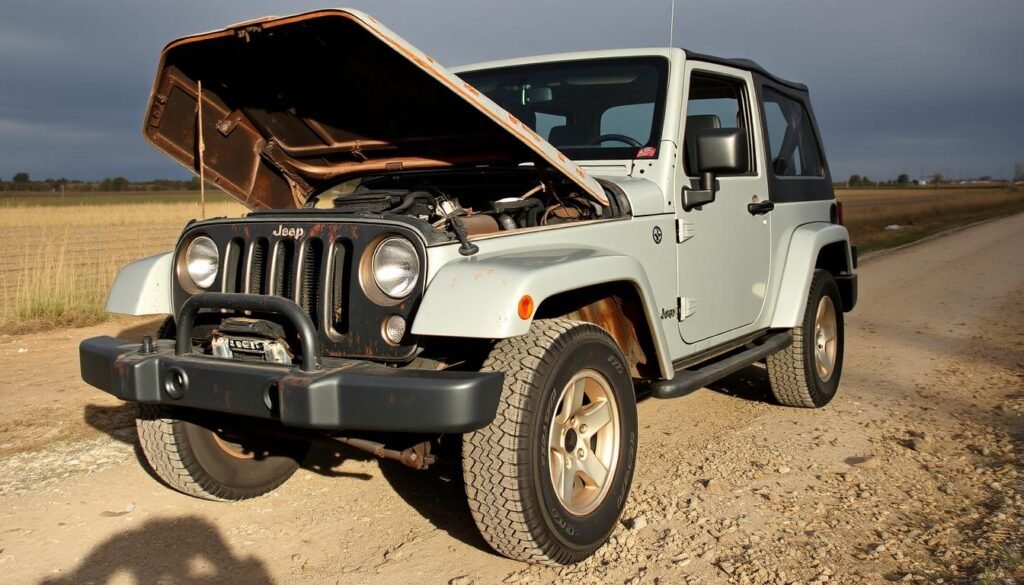Jeep started in Toledo, Ohio, and grew into a global leader. It went from making 500,000 SUVs in 2008 to 1.4 million by 2016. This shows how Jeep has changed the game.
Now, Stellantis owns Jeep, keeping its American tradition alive. Jeep is known for being very American, with over 2,400 U.S. dealerships. In 2021, it was the fourth most American-made vehicle.
Jeep’s factories are in the U.S., Brazil, China, Italy, Poland, and India. This global reach helps Jeep meet customer needs while keeping its American spirit alive.
The History of Jeep Manufacturing in America
The story of Jeep is a classic American tale of innovation and hard work. It started during World War II when the U.S. military needed a tough light reconnaissance vehicle. In July 1940, the Army asked 135 companies to compete for this important job.
Origins with Willys-Overland
Willys-Overland played a key role in Jeep’s history. Based in Toledo, Ohio, they quickly met the Army’s tough requirements. The Army wanted a vehicle under 1,300 lbs with amazing abilities. Willys-Overland’s design stood out from others like American Bantam and Ford.
Military Heritage and Production
During World War II, Willys-Overland showed incredible production skills. They made 368,000 military Jeeps, helping the U.S. Army a lot. Important moments included:
- The Willys MA prototype
- The famous Willys MB model
- Contracts for 1,500 test vehicles
Transition to Civilian Production
After the war, Willys-Overland easily moved to making Jeeps for civilians. The Jeep CJ-2A, made from 1945 to 1949, was the first for civilians. This change showed the brand’s flexibility and started a long success story in cars.
Current Jeep Manufacturing Facilities in the United States
The United States is the core of Jeep’s manufacturing, with several key sites. These places show Jeep’s strong commitment to making cars in America. They are also at the forefront of car innovation.
The Toledo Assembly Complex in Ohio is a major Jeep production site. It covers 3.64 million square feet on 312 acres. It has two main plants:
- North Plant: Makes the iconic Jeep Wrangler
- South Plant (Supplier Park): Produces the Jeep Gladiator
Stellantis has put a lot of money into these facilities. They spent a $1 billion to update the South plant for Gladiator production. The Toledo Complex has over 5,400 workers and is key to Jeep’s success.
The Jefferson North Assembly Plant in Detroit, Michigan, is another important site. It makes the popular Grand Cherokee. This plant is a big part of Jeep’s American car-making plan.
The Belvidere Assembly Plant in Illinois is also coming back. Stellantis plans to reopen it after it was closed in early 2023. This will create about 1,500 new jobs and keep the tradition of American-made Jeeps alive.
Stellantis shows its dedication to U.S. manufacturing by investing in these facilities. They keep making important Jeep models here.
Where Is Jeep Made Today
Jeep makes its vehicles in several key places in the United States. The company is proud to make its SUVs and trucks in America. Looking back at its history, Jeep remains a key player in American car making.

Jeep’s assembly plants are complex and dynamic. They are essential for creating some of the most loved off-road vehicles. These plants meet the needs of drivers all over the country.
Toledo Assembly Complex: Home of the Wrangler
In Toledo, Ohio, the Toledo Assembly Complex is where the Jeep Wrangler and Gladiator pickup truck are made. It produces 320,000 vehicles a year and has 5,851 workers. This shows Jeep’s skill in making cars.
Jefferson North Assembly Plant: Grand Cherokee Production
In Detroit, Michigan, the Jefferson North Assembly Plant makes the Grand Cherokee. It can make 500,000 vehicles a year and has 5,096 jobs. Car fans value the plant’s focus on quality.
Belvidere Assembly Plant: Cherokee’s Birthplace
The Belvidere Assembly Plant in Illinois used to make the Jeep Cherokee. It’s currently not making cars, but it can make 190,000 vehicles a year. It has been a big part of Jeep’s car making.
- Total US Jeep assembly plants: 5
- Annual production capacity across facilities: Over 1.5 million vehicles
- Jobs supported by Jeep manufacturing: Approximately 20,000
International Jeep Production Facilities
Jeep has grown into a global leader in the automotive world. It now makes cars in many places around the world. Stellantis has played a big role in Jeep’s success worldwide.
Some important places where Jeep makes cars include:
- Italy: The Melfi Plant makes about 300,000 cars every year
- Brazil: Goiana Assembly Complex produces 250,000 vehicles yearly
- China: Guangzhou Plant can make 328,000 cars (moving to Changsha)
- India: Ranjangaon and Pune plants make 245,000 cars together
- Mexico: Toluca facility makes 100,000 cars annually
These places mainly make popular models like the Renegade, Compass, and certain Cherokee versions. By making cars in different countries, Jeep saves on shipping costs. It also meets local rules and shows it cares about each region.
Jeep’s growth shows it knows how to make cars all over the world. It keeps its American roots while meeting global needs.
Made in America: Popular Jeep Models and Their Origins
Jeep is dedicated to making American-made Jeeps. Its iconic models show off American engineering and production. They reflect Jeep’s deep roots in America.

The U.S. is where Jeep makes its most popular vehicles. Each model has a story of American craftsmanship and innovation.
Wrangler: The Iconic American Off-Road Legend
The Jeep Wrangler is a symbol of American car excellence. It’s made at the Toledo Assembly Complex in Ohio. This place has been making cars for 82 years.
- Manufactured in Toledo, Ohio
- 72% U.S./Canadian parts content
- Employs nearly 6,500 workers
Cherokee: A Changing Manufacturing Landscape
The Jeep Cherokee has seen big changes. It used to be made in Illinois but stopped in 2023. It has 45% U.S./Canadian parts, showing how American car making is changing.
Grand Cherokee: Detroit’s Automotive Pride
The Grand Cherokee is made in Detroit. It shows American car making at its best. With 68% U.S./Canadian parts, it shows Jeep’s commitment to making cars in America.
In 2024, Jeep ranked #7 in Cars.com’s American-Made Index, underscoring its commitment to U.S. manufacturing.
The future is bright for American-made Jeeps. Electric models like the Jeep Recon and Wagoneer S will be made in Toledo and Detroit.
Jeep’s European Manufacturing Operations

Jeep’s European manufacturing has changed a lot after Chrysler and Fiat merged. This partnership formed Fiat Chrysler Automobiles (FCA). It changed how Jeep makes cars in Europe, mainly in Italy.
The Tychy plant in Poland is now a key place for Jeep’s European production. It has achieved a lot, including:
- Producing 100,000 Jeep Avenger units
- Winning the European Car of the Year 2023 for the Avenger
- Launching the e-Hybrid variant successfully
Now, Jeep in Europe is all about new and green technologies. The Avenger e-Hybrid shows this, with a 100 HP engine and a 21-kW electric motor. It has a 48-Volt hybrid system and a six-speed automatic transmission.
Stellantis, Jeep’s parent company, is making big changes in Europe. They want to be carbon neutral by 2038. The Tychy plant is getting new tech to make cars that don’t pollute much.
Some green steps at the plant are:
- Lowering energy use
- Reducing CO2 emissions
- Switching to green heat from biomass
By 2025, Jeep aims to have an electric version of every car. This shows their dedication to making cars better for the planet in Europe.
Global Parts Sourcing and Supply Chain
Jeep parts manufacturing is a complex global network. It spans multiple continents and strategic locations. The supply chain for Jeep vehicles uses smart sourcing strategies. These strategies aim to boost production efficiency and quality.
Stellantis, Jeep’s parent company, has a detailed approach to parts sourcing. It balances cost with high-quality manufacturing standards. The global supply chain links production facilities across regions. This ensures consistent vehicle performance.
Engine Manufacturing Locations
Jeep’s engine production focuses on key facilities. These facilities specialize in advanced powertrain technologies. The main engine manufacturing locations are:
- Trenton Engine Complex in Trenton, Michigan
- Saltillo South Engine Plant in Saltillo, Mexico
- Mack Avenue Engine Plant in Detroit, Michigan
The Pentastar V-6 engine is a key component in Jeep’s lineup. It comes in multiple displacement options:
- 3.6-liter variant
- 3.2-liter configuration
- 3.0-liter displacement
Transmission Production Facilities
Transmission manufacturing is another key part of Jeep’s strategy. The company uses advanced production facilities. These ensure high-performance transmission systems that meet strict quality standards.
“Our global supply chain allows us to maintain exceptional manufacturing precision across multiple production sites,” says a Stellantis manufacturing executive.
Jeep’s commitment to innovation drives its global parts manufacturing. It focuses on electrification and advanced manufacturing technologies.
The Future of Jeep Manufacturing
Jeep’s future looks bright as it plans to make more cars. Stellantis wants to sell 1.9 million Jeeps a year. They’re working hard to make this happen by using new ways to make cars.
Jeep is moving towards electric and hybrid cars. The Wrangler 4xe’s success led to plans for a hybrid Gladiator. Stellantis is also cutting prices to get more dealers and customers.
The Toledo Assembly Complex is a big part of Jeep’s plan. It saved 1,100 jobs and is now ready to grow. The Belvidere Assembly Plant will reopen in 2027, showing Jeep’s commitment to making cars in the US.
Jeep also wants to make cars for people all over the world. They’re doing well in Brazil, China, and might start making cars in India. This plan helps Jeep grow globally while keeping its American roots.
FAQ
Where are Jeep vehicles mainly made?
Jeep vehicles are mainly made in the United States. Key factories are in Toledo, Ohio (Wrangler and Gladiator), Detroit, Michigan (Grand Cherokee), and Belvidere, Illinois (Cherokee). They also have plants in Italy, Brazil, China, and Mexico.
Are all Jeep models made in the United States?
No, not all Jeep models are made in the United States. While many popular models like the Wrangler, Grand Cherokee, and Cherokee are made in American factories, some models like the Compass and Renegade are made in Italy and Brazil.
When did Jeep first start making vehicles?
Jeep’s history began in World War II. Willys-Overland started making military Jeeps in Toledo, Ohio. After the war, they made civilian Jeeps, starting their American manufacturing journey.
How many manufacturing plants does Jeep have?
Jeep has many manufacturing plants worldwide. They have three major plants in the United States (Toledo, Detroit, and Belvidere) and plants in Italy, Brazil, China, India, and Mexico. The exact number changes based on production plans.
Are Jeep vehicles made by Stellantis?
Yes, Jeep is part of Stellantis now. This happened in 2021 when Fiat Chrysler Automobiles (FCA) and the French PSA Group merged. This merger has shaped Jeep’s global production and strategy.
Do Jeep’s international manufacturing plants produce the same models as in the US?
Not always. International plants make models for their local markets. For example, the Melfi, Italy plant makes the Compass and Renegade. US plants focus on models like the Wrangler, Grand Cherokee, and Cherokee.
Is Jeep planning to expand its manufacturing capabilities?
Jeep is always adapting to new market demands and technology. They are looking into electric vehicle production. They might expand or change their plants to support these new technologies and meet global needs.


